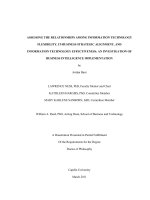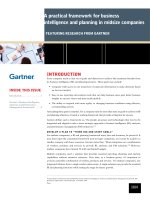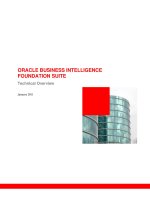unit 14 business intelligence 3
Bạn đang xem bản rút gọn của tài liệu. Xem và tải ngay bản đầy đủ của tài liệu tại đây (6.56 MB, 84 trang )
<span class="text_page_counter">Trang 1</span><div class="page_container" data-page="1">
ASSIGNMENT 2 FRONT SHEET
Qualification BTEC Level 5 HND Diploma in ComputingUnit number and title Unit 14: Business Intelligence
</div><span class="text_page_counter">Trang 3</span><div class="page_container" data-page="3">Summative Feedback: Resubmission Feedback:
Lecturer Signature:
</div><span class="text_page_counter">Trang 5</span><div class="page_container" data-page="5">2. Evaluate how this tool help ... 2
II. Boxplot chart ... 2
1. Analyze ... 2
2. Evaluate how this tool help ... 2
III. Bar Chart ... 2
1. Analyze ... 2
</div><span class="text_page_counter">Trang 6</span><div class="page_container" data-page="6">2. Evaluate how this tool help ... 3
IV. Correlation Matrix ... 33
1. Analyze ... 3
2. Evaluate how this tool help ... 3
D. Explore the legal issues involved in the secure exploitation of business intelligence tools. (P6) .. 34
I. Legal issues ... 3
1. Data Privacy ... 3
2. Intellectual Property ... 3
3. Contractual Obligations ... 3
</div><span class="text_page_counter">Trang 7</span><div class="page_container" data-page="7">II. Security issues ... 3
1. Data handling and storage ... 3
2. Cybersecurity Threats ... 3
3. Bias, Fairness & Discrimination ... 35
III. Business Intelligence Tools ... 36
Figure 2. Histogram about the adoption of Machine Learning in the enterprise ...
Figure 3. Bar diagram shows the number of language users based on level ...
Figure 4. Boxplot diagram for median salary of multiple work position ... 4
Figure 5. Business Process Diagram ...
Figure 6. Business Intelligence with Python ...
Figure 7. Python code in Spyder ...
Figure 8. Data Visualization by Python... 1
Figure 9. Tableau...
Figure 10. Tableau Desktop ...
Figure 11. Tableau visualization ... 1
Figure 12. Python visualization ... 1
</div><span class="text_page_counter">Trang 8</span><div class="page_container" data-page="8">Figure 13. Libraries needed ...
Figure 14. Filter data ...
Figure 15. Change Column data...
Figure 16. Before change ...
Figure 17. After change ...
Figure 18. New columns ...
Figure 19. Code for histogram ...
Figure 20. Histogram in Python ... 1
Figure 21. Code for boxplot ... 1
</div><span class="text_page_counter">Trang 9</span><div class="page_container" data-page="9">Figure 22. Boxplot in Python ... 1
Figure 23. Code for correlation matrix ... 1
Figure 24. Correlation Matrix in Python ... 1
Figure 25. Code for bar chart ...
Figure 26. Barchart in Python - C user ...
Figure 27. Barchart in Python R user – ...
Figure 28. Barchart in Python SQL user – ... 2
Figure 29. Barchart in Python - Python user ... 2
Figure 30. Save into new file ... 2
Figure 31. Histogram in Tableau ... 2
Figure 32. Boxplot in Tableau ... 2
Figure 33. Barchart in Tableau ... 2
Figure 34. Histogram made by using Python (Spyder) ... 2
Figure 35. Histogram made by using Tableau ...
Figure 36. Boxplot chart made by using Tableau ... 2
Figure 37. Boxplot chart made by using Python (Spyder) ... 2
Figure 38. Barchart in Tableau ... 2
Figure 39. Barchart in Python - C user ...
Figure 40. Barchart in Python - R user ...
Figure 41. Barchart in Python - SQL user ... 3
Figure 42. Barchart in Python - Python user ... 3
Figure 43. Correlation Matrix made by using Python (Spyder) ... 3
</div><span class="text_page_counter">Trang 11</span><div class="page_container" data-page="11">A. Determine, with examples, what business intelligence is and the tools and techniques associated with it. (P3)
1. Definition
Business Intelligence (BI) refers to the technology-driven process of collecting, analyzing, and presenting business data to support decision-making within an organization. The primary goal of BI is to help organizations gain a better understanding of their internal and external data in order to make informed business decisions.
Figure 1. Business Inteligence
There are many definitions and interpretations of BI. However, the most practical one is that BI is a health management profile, storing information for regular check-ups. Then, we will know our health in the future, what diseases we might have, and where our health will be weak,
</div><span class="text_page_counter">Trang 12</span><div class="page_container" data-page="12">, g , ,and it will notify us of that. Businesses undergo a "health check-up." BI will reveal what the business needs to ensure its health. That is BI in the most practical sense.
Key activities in the field of Business Intelligence includ e:
Data Collection: Organizations gather data from various sources, including internal databases, external market data, customer data, and competitive intelligence.
Data Processing: The collected data often needs to be processed and transformed into a suitable format for analysis. This may involve cleaning, aggregating, and structuring the data.
Data Analysis: BI involves using various analytical tools to explore data, discover trends, and gain insights into the relationships between different factors affecting the business.
</div><span class="text_page_counter">Trang 13</span><div class="page_container" data-page="13">Reporting and Visualization: BI tools provide capabilities for creating and customizing reports, dashboards, and visualizations. These help managers and decision-makers understand the information and make decisions based on data.
Predictive Analytics and Data Mining: Some BI systems incorporate predictive analytics and data mining techniques to forecast future trends and support strategic decision-making. BI enables organizations to enhance their flexibility and responsiveness in decision-making, mitigate risks, and optimize business performance. BI tools are often integrated with other enterprise systems to create a comprehensive information system.
2. Reason why I choose this business model
</div><span class="text_page_counter">Trang 14</span><div class="page_container" data-page="14">Figure 2. Histogram about the adoption of Machine Learning in the enterprise
The histogram illustrates the uptake of Machine Learning in distinct sectors. It indicates that the Computer/Technology industry boasts the highest level of adoption, followed by the Academics/Education sector. Evidently, these two sectors hold notably larger shares of the market compared to others, suggesting substantial potential and ample opportunities. Consequently, our business will primarily target these sectors. Given the rapid evolution of technology, engagement in the computer/technology industry promises numerous possibilities and innovation. Furthermore, this sector represents the largest market, nearly double the size of the second-largest
</div><span class="text_page_counter">Trang 15</span><div class="page_container" data-page="15">market. With its continuously expanding potential, this industry appears to be the most advantageous space for our company's involvement.
Our business will concentrate on devising projects to address challenges and aid enterprises in diverse capacities, including A.I. training, developing support software, and meeting the specific needs of businesses within the computer/technology realm. Consequently, meticulous attention must be paid to the screening of human resources to ensure that we assemble the most suitableteam for these endeavors.
</div><span class="text_page_counter">Trang 16</span><div class="page_container" data-page="16">Figure 3. Bar diagram shows the number of language users based on level
</div><span class="text_page_counter">Trang 17</span><div class="page_container" data-page="17">It can be seen from the chart above that a prevalence of master's level users across most languagesfollowed by bachelor's and doctorate-level users. This suggests an opportunity to target a talent pool that is both abundant and capable of attaining a master's degree, making it an appealing segment for recruitment. Across all languages surveyed, master's degree holders consistently represent the largescohort.
Moving on to the number of users for each language, focusing specifically on the master's level, it is apparent that Python, R, and SQL stand out as the most abundant and dominant languages, surpassinothers by a substantial margin. Consequently, these languages will serve as the primary focus for our company's project. The considerable user base for these languages translates to a large potential talenpool, simplifying the recruitment process and enhancing negotiating capabilities. Python will serve as our primary language for process development with over three thousand users, followed by R with over two thousand users, and SQL with approximately one thousand users.
Figure 4. Boxplot diagram for median salary of multiple work position
Through the boxplot chart above, we can see that job groups directly related to data have quite high average salaries. This is understandable because their job is quite heavy and must
</div><span class="text_page_counter">Trang 18</span><div class="page_container" data-page="18">q g g j q y
provide an accurate and quick view to be able to grasp the market quickly as well as leapfrog market trends. Meanwhile, jobs like programming or statistics have salaries that are not too high but not too low either. That's because their job is to determine and ensure the process. As for analysts, their work is multi-faceted. It is impossible to know in advance. Today may be as predicted, but the following days are uncertain. Therefore, the more you spend on good analysts, the more useful and accurate information you will receive in return. That's the reason why their average salary is so high because everyone wants to find a talented analyst to be able to grasp themarket accurately and quickly.
Having an overview of the market, market requirements and grasping trends to be able to stay ahead of the market will bring a huge advantage to the company when we can be one of the first units to do what the market needs. That way, we will eliminate a large number of direct competitors in the industry because the bigger the pie, the more people will want a piece.
</div><span class="text_page_counter">Trang 19</span><div class="page_container" data-page="19">3. Business Process
</div><span class="text_page_counter">Trang 20</span><div class="page_container" data-page="20">Figure 5. Business Process Diagram
</div><span class="text_page_counter">Trang 21</span><div class="page_container" data-page="21"> Market research and analysis
To ensure the stability of our business operations, we will commence with comprehensive market research and analysis, enabling us to approach the market methodically and insightfully. This rigorous market research will serve as a foundational step, providing the company with a clear direction for future projects.
Our initial focus will be on conducting market research and identifying industries in which we can develop solutions. This will pave the way for our company's entry into the market. Following the planning phase, the next crucial step involves selecting the most suitable programming language for the project. This is vital, as the language being the most commonly used may not necessarily align with the specific requirements of the solution. Subsequently, we will proceed to recruit the necessary personnel for the project.
The budget is undeniably a critical factor. Without adequate funding, operational progress is impeded. It is imperative to carefully calculate expenses to determine the budget and forecast costs for the entire plan. If the budget falls short, it will hinder the project's execution. Conversely, with sufficient funding, we can proceed to the final stage of this phase, which involves recruiting the necessary personnel for the project and initiating its implementation.
Solution Design and Development
In this stage, ideas are generated, concepts are formulated, and the foundational framework of the software solution is delineated. This phase is pivotal as developers define the problem they aim to address and conceive an effective software solution. Subsequently, the "Determine scope, features,functionalities, legality" process follows the design phase. This stage involves evaluating the software's functionality, anticipated features, and scope, as well as assessing the legal aspects ofsoftware development, encompassing issues related to intellectual property rights and compliance with data protection laws.
A crucial aspect that follows is the assessment of the chosen programming or development language to determine its appropriateness for realizing the envisioned design. Selecting the right language is a critical step in the software development process, as it significantly impacts the program's effectiveness, performance, and usability. If the chosen language is deemed unsuitable, the feasibility of modifying the project or language is examined. This entails assessing whether adjustments can be made to align the design and the chosen language. If modifications are feasible, the process loops backto the design stage, signaling the need for a reassessment and redesign of the solution.
</div><span class="text_page_counter">Trang 22</span><div class="page_container" data-page="22">to the design stage, signaling the need for a reassessment and redesign of the solution.
However, if adjustments are not feasible, the process regresses to the language research stage toidentify an alternative language that aligns with the plan. The process then recommences from the beginning until the desired outcome is achieved.
Upon confirmation of the suitability of the chosen language, the process advances to the final stage, which entails creating a prototype. In this phase, a prototype or preliminary version of the software is developed, enabling developers to assess its functionality and make necessary adjustmentsbefore final deployment..
Prototyping
</div><span class="text_page_counter">Trang 23</span><div class="page_container" data-page="23">The initial step in this phase involves developing prototypes, which are early versions of the product. These prototypes serve as a tangible representation of the product and allow developers toevaluate its functionality.
Subsequently, we progress to the testing and feedback stage to validate the prototypes. Here, extensive testing is conducted on the prototypes, and stakeholders or users provide their feedback toidentify any weaknesses or potential areas for improvement.
Following the validation process, an assessment is made to determine if the prototypes meet our expectations and adhere to the specified requirements. If the response is negative, the process revertto the initial phase, signifying the need for further refinement and development of the prototypes.
If the prototypes successfully fulfill the requirements, the process advances to the phase of refining and enhancing the solution. Here, the solution is adjusted and improved based on feedback and testresults from the validation phase.
A crucial inquiry that arises is whether additional prototyping is necessary. This evaluation determines if further prototyping is essential. If the answer is "Yes", the process returns to the initial step for further development of prototypes. If the answer is "No", the process proceeds to the final step, "Proceed to development", which marks the transition from prototyping to the actual development of the product.
Further Development and Deployment
The process commences with the commencement of full-scale development. During this phase, the product is concretely developed with the prototypes and design serving as a guide. Developers translate the design into a functional product in this crucial stage.
The subsequent step entails deploying the solution on suitable infrastructure. This phase involves establishing the required infrastructure to support the solution and deploying the developed product onto this infrastructure.
Following the deployment phase, integration testing and quality assurance activities are undertaken. This marks the outset of the product's functional and performance testing phase. Verifying that the product aligns with predetermined quality standards and requirements falls within the scope of quality assurance.
The subsequent phase involves assessing the product's quality. This step evaluates if the product
</div><span class="text_page_counter">Trang 24</span><div class="page_container" data-page="24">meets the defined quality standards. If the response is negative, it indicates the necessity to addresserrors and adjust the product, signaling a requirement for further refinement and bug fixing. Upon successful verification of the quality, the process proceeds to the final stage, which is the product launch. This stage signifies the official introduction of the product to the market.
Product launch and Maintain
This phase marks the culmination of the process. Its primary task is to develop and implement marketing strategies for our product. This entails formulating a comprehensive marketing strategy, defining the target audience, understanding their needs, and positioning the product to address thoseneeds.
</div><span class="text_page_counter">Trang 25</span><div class="page_container" data-page="25">The subsequent action step focuses on product launch and customer acquisition. Introducing the product to the market and acquiring clients are the primary objectives of this phase, involving activities such as sales tactics, advertising campaigns, and promotional events.
Following the product launch, the subsequent phase emphasizes customer support, feedback collection, and survey administration. This stage underscores the significance of feedback and customer service in the development of new products. Conducting surveys, gathering feedback, and providing customer support are integral components of this phase to gain insight into customers' experiences with the product.
The next step in the progression evaluates whether the feedback indicates high user satisfaction with the product. If the response is negative, the process moves to the stage of updating and maintaining solutions, denoting the need for further refinement and improvement of the product.
Conversely, if the feedback indicates high customer satisfaction, the process advances to the final step, prioritizing product enhancements and continuous development. This stage underscores the importance of ongoing development, even in the presence of significant user satisfaction. It involves refining the product's features and making adjustments in response to evolving consumer demands andindustry trends.
1. Python
Python is a versatile and powerful programming language widely used in various fields, including data analysis, artificial intelligence, web development, and many other applications. It has simple, readable syntax, making it easy for beginners to quickly learn and master.
</div><span class="text_page_counter">Trang 26</span><div class="page_container" data-page="26">Figure 6. Business Intelligence with Python
In the realm of Business Intelligence (BI), Python plays a crucial role in several aspects: Data Analysis: Python provides powerful libraries such as Pandas, NumPy, and SciPy,
facilitating efficient data analysis and processing.
</div><span class="text_page_counter">Trang 27</span><div class="page_container" data-page="27">Data Visualization: Libraries like Matplotlib and Seaborn help create charts and graphs to visually represent data in an understandable manner.
Data Connection and Retrieval: Python has libraries like SQLAlchemy and PyODBC, enabling connection and retrieval of data from various sources, including databases, Excel files, and APIs.
Machine Learning and Prediction: Python is a powerful tool in the fields of artificial intelligence and machine learning. Libraries like Scikit-learn and TensorFlow support the building of prediction and classification models.
Automation and Automated Reporting: Python can be used to automate repetitive tasks in BI processes and generate automated reports.
Web Development and Integration: Python has frameworks like Flask and Django, aiding in building web applications and integrating BI into organizational systems.
Open Source and Large Community: Python is an open-source language with a large programming community. This means abundant resources, libraries, and community support.
In our case, we have applied Python for data analysis and data visualization through the Spyder software, which integrates several libraries such as Pandas and NumPy for numerical analysis. Additionally, it is further supported by the Matplotlib and Seaborn libraries (installed externally, or integrated if using Anaconda with Spyder). Python proves to be quite flexible in data processing; however, for visualization, it may not stand out as much. Therefore, we use Tableau to enhance the visual aesthetics compared to Python.
</div><span class="text_page_counter">Trang 28</span><div class="page_container" data-page="28">Figure 7. Python code in Spyder
</div><span class="text_page_counter">Trang 29</span><div class="page_container" data-page="29">Figure 8. Data Visualization by Python
2. Tableau
Tableau is a powerful data visualization and business intelligence (BI) platform that allows organizations to turn raw data into meaningful insights. It provides interactive and shareable dashboards, reports, and charts, making it easier for businesses to understand complex datasetsand make data-driven decisions
</div><span class="text_page_counter">Trang 30</span><div class="page_container" data-page="30">Figure 9. Tableau
Tableau, with its robust set of features, stands out as a leading data visualization and business intelligence platform. Its intuitive data visualization capabilities empower users to craft visually stunning and interactive dashboards effortlessly, eliminating the need for extensive coding or technical expertise. The platform's strength lies in its connectivity, offering seamless integration with a diverse range of data sources, including databases, spreadsheets, and cloud-based repositories. Tableau's real-time data analysis feature enables users to gain quick insights into dynamic trends, while the drag-and-drop functionality simplifies the creation of charts, graphs, and maps. The ability to blend data from various sources ensures a comprehensive
</div><span class="text_page_counter">Trang 39</span><div class="page_container" data-page="39">Figure 17. After change
Figure 18. New columns
Our initial step involves creating a histogram to visualize the distribution of AI/machine learning adoption across different industries. To achieve this, we will tally the occurrences of industries in the dataset, specifically in column Q24, representing the current industry of the respondents. Seaborn will be employed to generate the histogram based on the values in column Q24. Subsequently, we will utilize matplotlib to modify the x-axis label, ensuring it provides more context than just "Q24." Additionally, we will rotate the names of the industries 90 degrees for
</div><span class="text_page_counter">Trang 40</span><div class="page_container" data-page="40">improved readability.
Figure 19. Code for histogram
</div>








